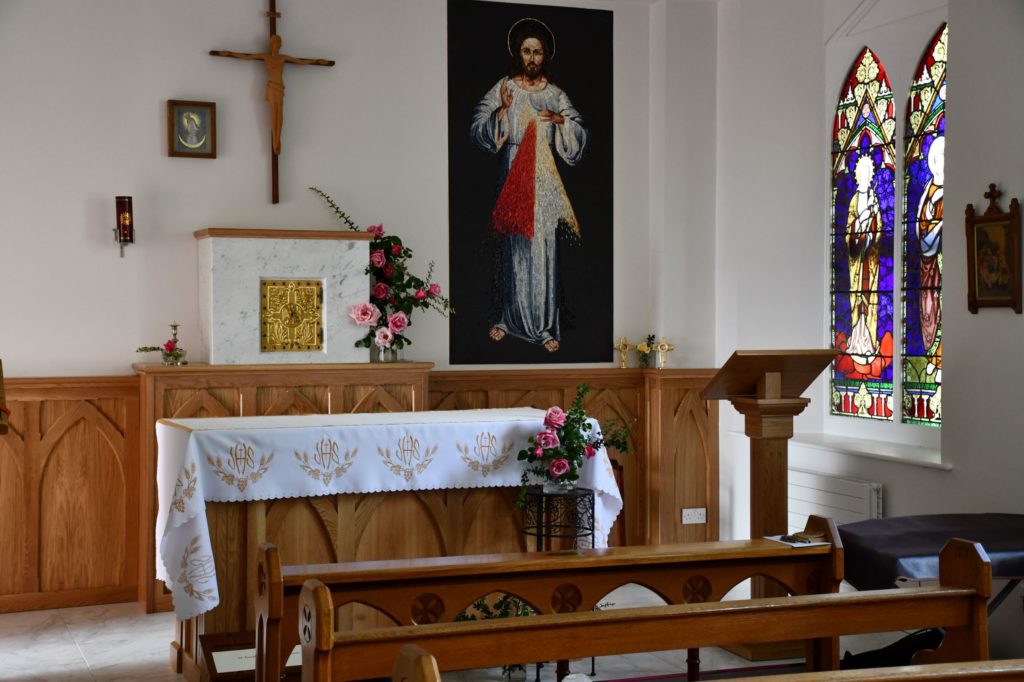There are only two known ecclesiastical works by Goldie in Donegal; one is partially demolished and the other has had much interior alteration but remains structurally intact and in use. Goldie also designed one civic monument that is worth mentioning as it was removed and is missing from its original location in Letterkenny. The religious buildings are the church at Convoy and the former Loreto Convent in Letterkenny. The civic monument was a clock for the Market Square in Letterkenny. Goldie was also the proposed original designer for St. Eunan’s Cathedral in Letterkenny but due to financial constraints the building was put in abeyance and eventually the designs of a different architect were used at a much later date.
St. Mary’s Church, Convoy.
All that stands of the church at Convoy is the bellcote and partial nave with a pointed arch entrance. The building is located in the village graveyard. The NIAH suggests that the church was built by the architect John O’Neill .
As stated in the NIAH entry, there had been an older church built on the site during the late eighteenth/early nineteenth-centuries. This church was renovated to the extent that it might be classed as a new building, this was an observation made by a correspondent writing for the Londonderry Journal, in 1866. As the church stands now (as not much more than a maintained ruin), we are lucky to have some idea of how it might have looked from the report carried in the Londonderry Journal. Goldie designed the interior with three galleries along with the altar and reredos, we can imagine that these would be in the image of his other small church furnishings such as can be found in Tibohine, Co. Roscommon. The chancel and the belfry were also designed by Goldie, to extend the church. The exterior that remains is thus the work of Goldie. Goldie attended the dedication and dined afterward with the Bishop of Raphoe, Rev. Dr. McGettigan.

St. Mary’s, west side view. 
St. Mary’s, showing doorway. 
St. Mary’s, rear of gable. 
St. Mary’s, bellcote and gable
The Loreto Convent.
Bishop McGettigan was also involved in the establishment of the Loreto convent in Letterkenny. McGettigan had gifted the Loreto nuns his residence and grounds for the purpose of establishing the convent and a school. From a report in the Dublin Evening Post we learn that there was insufficient space for the building to function as both so they built an extension, designed by Hadfield and Goldie, to accommodate the pupils they wished to educate. According to The Freeman’s Journal, the convent itself was the first to be established in the Diocese of Raphoe since the Reformation. Alterations to the convent were commenced in 1860, at the same time that Hadfield and Goldie were completing another convent for the Loreto Order in nearby Omagh, Tyrone.
The extension was described as a ‘most beautiful Gothic edifice’ by The Freeman’s Journal, which also provides a very useful description of aspects of the building that allow us to determine how much of the chapel designed by Goldie still remains. Although the exterior of the building is very much intact and as it was when first built, there have been many interior alterations. The chapel has been very much changed, the altar and any reredos have been lost and replaced with simple wooden furnishing but the tabernacle door designed by Goldie is still in situ, as are the Stations of the Cross (local information- Robert Spence, Divine Mercy Centre, Letterkenny). The stained glass windows in the present chapel appear to be those designed by Goldie and made by Barff and Co., Dublin as they are identified in The Dublin Builder as portraying ‘Our Lord, The Blessed Virgin and St. Joseph.’ Barff provided numerous stained glass fittings for churches and convents in Ireland and England during the nineteenth-century revival of Catholic church building.
The Convent is now the residence of the Sisters of the Merciful Jesus who operate retreats, talks and other religious services from what is now known as the Divine Mercy Centre.

Tabernacle 
Stations of the Cross 
Stained Glass: Blessed Virgin and St. Joseph 
Loreto Convent Exterior 
Chapel Interior View 
Exterior, showing basement level. 
Loreto Convent Exterior 1 
Loreto Convent Exterior Detail.
St. Eunan’s Cathedral.
The present St. Eunan’s Cathedral in Letterkenny is a magnificent Gothic building designed by the architect William Hague but it could have easily been built to designs by George Goldie. Goldie had submitted designs for the rebuilding of an older chapel on the site and the foundations were laid for a tower to be followed by a Romanesque cathedral. This was carried out under the direction of Bishop McGettigan but the cathedral was not completed due to his many other commitments and a lack of finance. The Irish News and Belfast Morning News remarked that Goldie’s design was ‘obviously very beautiful.’
The Clock Tower on Market Square
The clock tower has disappeared from the streetscape of Letterkenny and was the subject of a search by the local county museum as recently as 2014.
The clock tower, designed by Goldie, stood at 45 feet high in the town’s Market Square and topped with a celtic cross. The tower was made of Scotch granite and local Culdaff stone. There was door at the rear of the tower that allowed access for the clock keeper and a platform encircled the tower just below the clock, also to help with upkeep. There was to have been a ‘strong iron railing’ placed around the base of the plinth of the tower but this doesn’t show in any available images of the clock. The clock was a gift from a Mr. John Boyd of Ballymacool, Donegal to the Town Council. The clock itself was made by Newman, clockmakers, Letterkenny.
